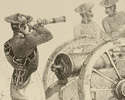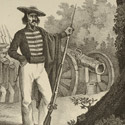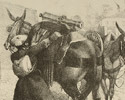19th Century´s militar history in the Basque Country
The carlist artillery
 Although at the start of the war, the Carlists had four cannons belonging to the Royalist Volunteers of Vitoria, they lost them a few days afterwards when their volunteers dispersed. There was no Carlist artillery as such until the end of 1834, when two cannons were taken from O'Doyle in Alegría de Alava, and Vicente Reina joined the Carlist lines and began to produce new units.
Although at the start of the war, the Carlists had four cannons belonging to the Royalist Volunteers of Vitoria, they lost them a few days afterwards when their volunteers dispersed. There was no Carlist artillery as such until the end of 1834, when two cannons were taken from O'Doyle in Alegría de Alava, and Vicente Reina joined the Carlist lines and began to produce new units.
 Zumalacárregui was told of the existence of an old cannon on a beach in Vizcaya and ordered it to be moved to Urbasa, where it was buried until a use could be found for it. Given the type of warfare initially used by the Carlists, the cannons could not be moved and were therefore buried until they could be used. When the volunteers saw the Vizcaya cannon, covered in mildew, they christened it el abuelo (grandpa). It was used with the cannons produced by Reina to take Irurzun, Echarri-Aranaz, Treviño and Ordizia. It burst on a number of occasions, but was simply fixed and continued to serve the artillery. When they acquired new units after the first siege of Bilbao, the Carlists stopped using el abuelo.
Zumalacárregui was told of the existence of an old cannon on a beach in Vizcaya and ordered it to be moved to Urbasa, where it was buried until a use could be found for it. Given the type of warfare initially used by the Carlists, the cannons could not be moved and were therefore buried until they could be used. When the volunteers saw the Vizcaya cannon, covered in mildew, they christened it el abuelo (grandpa). It was used with the cannons produced by Reina to take Irurzun, Echarri-Aranaz, Treviño and Ordizia. It burst on a number of occasions, but was simply fixed and continued to serve the artillery. When they acquired new units after the first siege of Bilbao, the Carlists stopped using el abuelo.
In 1835, the artillery brigadier Joaquín Montenegro joined the Carlists to organise the corps and take command for the duration of the war. He set up the Zubillaga foundry and arsenal in Oñate and even organised an academy for artillerymen. Thanks to his organisational skills, the Carlists had sixty to seventy cannons for the majority of the conflict. However, the followers of Don Carlos never had an artillery large enough to take a strong city such as Pamplona or San Sebastián, and were also inferior to the Liberal artillery in the sieges of Bilbao.
 The gunpowder and bullet factories were itinerant at the outbreak of the war, though after 1836 they were set up in Tolosa, Villarreal de Alava and Las Amescoas. Nonetheless, the main source of arms and ammunition for the Carlists in the first phase of the war was the Liberal army. By way of example, in January 1834,, Zumalacárregui took the arms factory of Orbaizeta and confiscated a cannon and 50,000 cartridges.
The gunpowder and bullet factories were itinerant at the outbreak of the war, though after 1836 they were set up in Tolosa, Villarreal de Alava and Las Amescoas. Nonetheless, the main source of arms and ammunition for the Carlists in the first phase of the war was the Liberal army. By way of example, in January 1834,, Zumalacárregui took the arms factory of Orbaizeta and confiscated a cannon and 50,000 cartridges.

